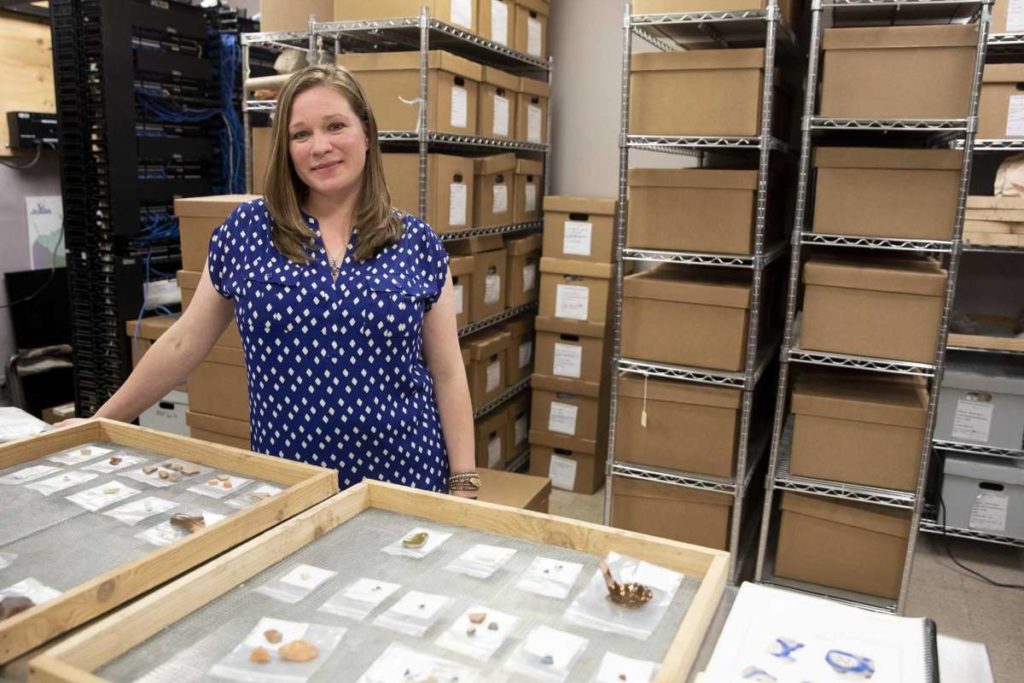
Growing up, archaeologist Rhiana Ward didn’t aspire to be like the bullwhip-wielding adventurer Indiana Jones or Tomb Raider Lara Croft — she wanted to be a veterinarian.
Her subconscious said otherwise.
Looking back, she found there was always a gravitational pull to the career that rouses her from bed early in the morning.
But there’s really no explanation why Lisa and Chris Casias’ only child had a desire to romp in the backyard and pretend she was collecting artifacts. Nor was there a clue as to why she would smear berries on rocks as if painting the craggy wall of a prehistoric cave, splattering juice on her clothes, horrifying her mother.
It wasn’t until her third year of studying for her undergraduate degree at the University of Texas at San Antonio that she could envision a career in archaeology. After a month of field school in Belize, Ward fell in love with the study of human history, the nitty-gritty of uncovering untold stories and underrepresented populations.
“That is a part of archaeology that I absolutely love,” said Ward, 34. “It’s not about artifacts, it’s about being able to tell the story of people who no longer have a voice and the imprint they left.”
For the past four years, Ward has worked at Raba Kistner, an engineering consulting and program management firm, as an assistant director of cultural resources. She has worked as field technician, crew chief and field director and has authored numerous professional and academic publications.
Born and raised in San Antonio, Ward is proud of projects she has worked on across the city, including City Hall renovations, San Pedro Creek redevelopment and Alamo preservation and restoration.
A fifth-generation Texan, Ward said it’s an honor to investigate the heritage of people who could be her ancestors. Her ancestry includes immigrants from Poland, Germany and northern Mexico.
In 2009, Ward earned a bachelor’s in anthropology from UTSA and in 2013, a master’s in anthropology from Texas Tech University.
Ward said that before anyone moves up the ranks of cultural resource management, they have to delve into the meat and bones of the job.
Early on, that meant putting in long hours of shovel bumming, a term that describes the life of a professional archaeologist. She traveled from project to project and lived off per diem and out of the trunk of her car.
Those were often 13-hour days, working seven days a week, on digs and surveys in sweltering heat. She would clamber down a ladder to carefully coax out history embedded in rock and stone with a trowel, hand pick or specialty shovel.
This was her life, her work across the southern United States and Belize, tucked into 3-foot-by-3-foot holes excavated several feet underground.
Ward said she’s inspired by the memory of women archaeologists who came before her, the ones who paved the way for her and future generations.
She said that up until 20 years ago, archaeology had been a male-dominated field of study. In recent years, more women have transitioned into the field as principal investigators and taken lead roles.
Ward said Raba Kistner’s team of 12 archaeologists includes eight women.
One of the proudest moments of her career came on a 17-month-long Alamo project, the longest field investigation of her career to date. For the duration of the project, the majority of 10 to 18 team members were women.
“They were amazing,” Ward said. “There’s no way that project could have gotten done without every single one of those ladies’ help. I was really honored and privileged to work with all of them and be able to lead them in the field.”
Ward started the project five weeks’ pregnant and now has a 1-year-old daughter. She has faced her share of challenges while juggling her career and home life.
In her early years, a landowner would not allow her onto his property because he believed a woman could not do the work of an archaeologist. There have also been issues at some construction sites where workers have questioned that she was in charge when it came to resources.
Ward said the keys to her success have been persistence, good timing and support from her husband, Jeff, parents, in-laws and peers.
Being the mother of a 1-year-old daughter and a 6-year-old son while working as an archaeologist has required endurance, but she’s been able to balance her work and home with the help of her network.
“Having family all around me is such a blessing,” she said. “I’m lucky I get to go home at night.”
Writing is the most strenuous and draining part of her projects, she said. But there’s always a sense of pride when the work is complete and she hits the submit button.
“Hopefully in 50 years, another archaeologist will look and see the work I have done,” Ward said, “and acknowledge the hard work that was done on it.”












